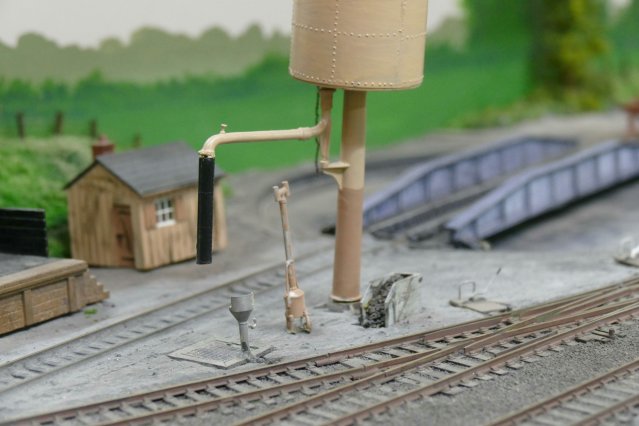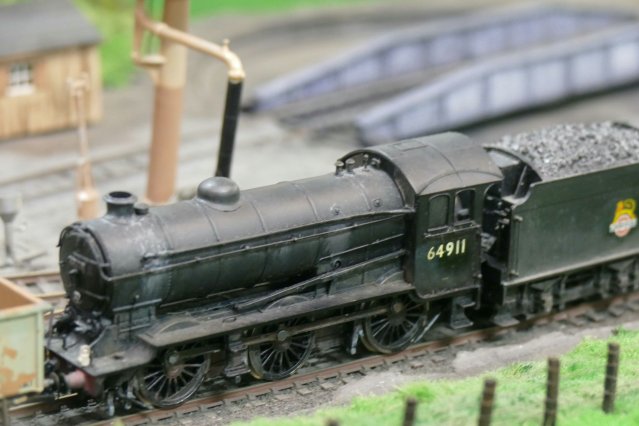FAIRFORD
4mm, OO gauge Great Western to British Rail
![]()

Yet another model of an archetypal Great Western branchline? However, many of them started life as independent companies and so they were often very different, though the GW stamped its character through many of the more subtle aspects, such as locomotives, rolling stock, signals, furniture, and of course the company ethos.
ORIGINS OF THE FAIRFORD BRANCH
The origin of the Fairford branch is quite interesting and is relatively late as far as branchlines go. The branch to Witney (the Witney Railway) was fairly early (built1860) but was opposed by the GWR, though it was worked by the Oxford, Worcester & Wolverhampton Railway (OWW), which quickly became part of the West Midland Railway and the GWR by 1863 . The junction of the Witney branch to the main OWW at Yarnton also provided a possible connection to the LNWR, and he GWR was always wary of competition from its rival. The risk of the LNWR having a potential route to Cheltenham via Witney profoundly affected the final outcome of the line to Fairford.
The East Gloucestershire Railway Company, around 1861, set out to do something rather different to what it actually achieved. As an independent company its aim was to promote a line from Faringdon, on the GW main line, to Cheltenham, by a rather shorter route than the 'Great Way Round' which went via Swindon, and Gloucester, and also to create a branchline to Witney. The connection at Yarnton, which linked to the LNWR provided the possibility of the LNWR getting to Cheltenham - not something the GWR wished to see! At this time the GWR had not taken over the OWW and the Witney Railway. The GWR played dirty tricks, by agreeing to support the East Gloucestershire Railway, which gained Royal Assent in 1862, only to later pull the plug, saying the proposal was a financial risk. As a result the line did not start at Faringdon and neither did it reach Cheltenham, but managed to build the branch from Witney to Fairford in 1873, becoming. a long archetypal GWR branchline from Oxford into rural East Gloucestershire worked by the GWR from the start until finally absorbed in 1890. Such was railway politics.
It was a long branchline, 25 miles to Oxford, with typical agricultural traffic, the blanket traffic from Witney and a period of greater activity in WW2 that caused an extra siding to be laid at Fairford - with the well known airfields of Fairford and Brize Norton on the line. The branch was also used for trials of the GW automatic train control.
The reason for this short history is that it leaves plenty of scope for the 'what if' scenario. What if the line had been built to Cheltenham - with those nice big green Great Western Halls and Castles using a secondary route. Maybe it could even have become the mainline to Cheltenham via Oxford, but then the track layout would be nothing like Fairford, as it would have been double tracked. My imagination is running away.
Because of the length of the branch, a turntable was provided at Fairford and locos ran round their trains and were turned - even Pannier tanks, so they faced the direction of travel! Operationally several loco crews and a set of cleaners were based at Fairford. Two locos were shedded at Fairford overnight, normally two Pannier tanks, with complaints from the cleaners, who worked a night shift, if one was a 45xx small praire because the shed doors could not then be closed. Some GW branches had quite complex operating diagrams - with stock operating to destinations along the mainline. Four loco crews worked from Fairford, starting duty at staggered times and changing trains on the branch in order to work home.
More information on the branch is provided in 'Great Western Branch Lines' Paul Karau published by OPC.
THE MODEL
![]()

The model also has a somewhat convoluted history. Like a number of Leeds club layouts Fairford has it its origins with long time club member Alan Smith who produced 4 boards with tracks laid, wired, points with motors, control panel, basic scenery and a box full of building kits, all of which had quietly slumbered in his loft for some time. Most of the hard work had been done. 'Can you do anything with this, and turn it into a club layout' said Alan. With no 4mm club layout at the time - the answer was 'yes, of course we can'.
Although it is called Fairford, the track plan has taken some liberties, with the addition of a number of double slips, that I doubt whether the Great Western would have installed on a branch line, let alone the impecunious East Gloucestershire who actually built the line. Some thought was given to using the names of other Cotswold towns an extended line would likely have served eg Northleach.
An extra board was added to lengthen the sidings, and a turntable fiddle yard added with 9 roads that can take 3coaches and a tender loco on the longest and straightest road. The baseboards and legs are unremarkable. They do crate together. Track and points are all Peco.
Buildings, signals etc (from the Smith collection of kits amassed for the layout) were divvied out among those interested and actually re-appeared as items for installation. A new power supply and controllers were provided although the old control panel has been used, as it had provision for two controllers. The addition of a number more isolation sections allows far more locos to be present on the layout than the prototype. This is probably a requirement of club and exhibition use that would not be needed for one person seeking to create a prototypical GWR branchline.
![]()

I was also interested in seeing what could be accomplished using readily available kits. The Ratio station building and GWR signal box, pagoda shelter, two Airfix engine sheds, Ratio GWR signals operated with cord and elastic bands etc were all part of the 'inheritance' and have preformed their role well in creating a typical GWR branchline atmosphere. Only the Goods Shed was built according to prototype. There are good drawings of the prototype buildings in the OPC book. The layout shows what can be achieved using 'off the shelf' kits that do not require great amounts of skill in putting them together.
Some improvements were made, Mike was not satisfied unless the buildings had interiors and working lights, as well as the platform gas lights. It looks very atmospheric if the layout is in dim light.
The width of the layout does not permit much in the way of scenery. Grass is 'distressed teddy bear fur' dyed with emulsion paint and trimmed with scissors to achieve coarse long grass for the embankment or 'munched' grass in the sliver that represents the adjacent field. Trees have been made from SeaMoss and Woodland scenics. Like many a branch the station was a mile from the town and the surroundings were rural. A road bridge conveniently crosses the station mouth and provides a good scenic break.
The layout has a number of cameos - mainly the station area, a single platform with station buildings and signal box on the platform and adjacent goods shed, and at the other end of the layout, the engine shed, turntable, water crane etc. In between the tracks are used for goods and the run-round for the passenger services. Two sets of coaches were stored overnight at Fairford. Photos show 2 or 3 coach trains sometimes with a bogie van.
![]()

The presence of a turntable, which was used for turning pannier tanks provides an excuse for bigger engines. In reality 0-4-2T, 0-6-0T, small praire, Dean Goods and Collet 0-6-0 Goods were the usual motive power. A steam railmotor was used in the early 20th century. Autocoaches are typical GW branchline fare, but most pictures show 3 coaches in service, In the 20's excursions were run for Fairford carnival. The excursions were often too long for the run-round and were pulled along the adjacent track with a wire rope, to allow the loco to complete its run round. We have not found a way to reproduce this on the model.
STOCK
Much of the stock can be replicated these days with the good products from Bachmann and Hornby - mostly Bachmann for the GWR, along with other 'typical' GW stock. Several eras can be represented by members stock - GW early1930's, GW late 30's/40's, early BR and later BR. The line actually closed in the 1960's but we may run early diesel era. Locos include 14xx 0-4-2T from Dapol/Hornby or my vintage K's 1950's model, 45xx small prairies, 57xx 0-6-0T, 2251 0-6-0, Dean Goods, were all used on the branch. The less prototypical GWR locos could be 56xx 0-6-2T, large praire 2-6-2T, Manors and I could not resist a Hall though the track would not have stood it.
I enjoy building and painting stock, especially coaches in fully lined liveries. Some of the coaches therefore have diverse origins eg Westdale aluminium shells, etched kits, scratchbuilt from Plasticard.
OPERATION
For exhibition a consistent era is run, but may change depending on the whim of the operator as it does not take long to change the trains. As the GW infrastructure barely changed in 50 years few changes are needed to the layout, unless we have found some road vehicles to put on the layout. Trains are 'run' for exhibitions - as viewers melt away when nothing happens. So - no timetable then - provide as intensive and as varied a pattern of trains as possible. Use the 9 roads in the fiddle yard, which can then be turned so locos are all facing the direction of travel.
